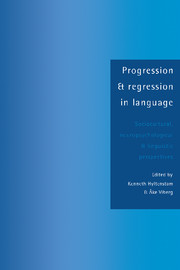 Progression and Regression in Language
Progression and Regression in Language Book contents
- Frontmatter
- Contents
- List of contributors
- Preface
- INTRODUCTION
- THE SOCIOCULTURAL SETTING
- PSYCHO- AND NEUROLINGUISTIC ASPECTS
- THE LINGUISTIC PERSPECTIVE 1: DISCOURSE, GRAMMAR, AND LEXIS
- 10 Crosslinguistic perspectives on native language acquisition
- 11 Syntactic development in Danish L2
- 12 The weaker language in bilingual Swedish-French children
- 13 Four operating principles and input distribution as explanations for underdeveloped and mature morphological systems
- 14 Crosslinguistic perspectives on lexical organization and lexical progression
- 15 Attrition or expansion? Changes in the lexicon of Finnish and American adult bilinguals in Sweden
- THE LINGUISTIC PERSPECTIVE 2: PHONOLOGY
- Index
15 - Attrition or expansion? Changes in the lexicon of Finnish and American adult bilinguals in Sweden
Published online by Cambridge University Press: 06 July 2010
- Frontmatter
- Contents
- List of contributors
- Preface
- INTRODUCTION
- THE SOCIOCULTURAL SETTING
- PSYCHO- AND NEUROLINGUISTIC ASPECTS
- THE LINGUISTIC PERSPECTIVE 1: DISCOURSE, GRAMMAR, AND LEXIS
- 10 Crosslinguistic perspectives on native language acquisition
- 11 Syntactic development in Danish L2
- 12 The weaker language in bilingual Swedish-French children
- 13 Four operating principles and input distribution as explanations for underdeveloped and mature morphological systems
- 14 Crosslinguistic perspectives on lexical organization and lexical progression
- 15 Attrition or expansion? Changes in the lexicon of Finnish and American adult bilinguals in Sweden
- THE LINGUISTIC PERSPECTIVE 2: PHONOLOGY
- Index
Summary
INTRODUCTION
It is within the lexicon that bilinguals report the most dramatic changes in their first language (LI) after acquiring a second language (L2). On the one hand, they report word-finding problems. On the other hand, they are appalled by the L2-origin words that creep into their speech in LI in various forms. This paper will discuss the second of these phenomena, and contrast the patterns of incorporations of Swedish-origin lexemes into the English and the Finnish of adult bilinguals living in Göteborg.
In several recent studies, researchers claim that there are general, structural constraints on certain types of incorporation, notably code-switching. In a relatively early study of incorporation, Hasselmo (1974: ch.5) proposes the ‘hypothesis’ that incorporation of English lexemes in American Swedish follows an ‘ordered choice’ hierarchy (see below). He makes no strong claims of generality, however. DiSciullo, Muysken, and Singh (1986) claim that structural constraints on code-mixing (what I and others prefer to call code-switching) follow the general principle of government. Poplack (1980 and later papers) claims that code-switching, narrowly defined, follows a general ‘equivalence constraint’ (see below). While the debate on ways of characterizing candidates for structural constraints on code-switching, borrowing or both goes on, the role of the social context of language contact seems to have been neglected. The purpose of this chapter is to examine some of these claims of universality or predictability of patterns of incorporation in relation to data of incorporation of Swedish lexemes in the Finnish and English of Finnish and American first generation immigrants in Sweden. I suggest, in this connection, that it may be premature to propose universal structural constraints on code-switching.
- Type
- Chapter
- Information
- Progression and Regression in LanguageSociocultural, Neuropsychological and Linguistic Perspectives, pp. 384 - 412Publisher: Cambridge University PressPrint publication year: 1994
